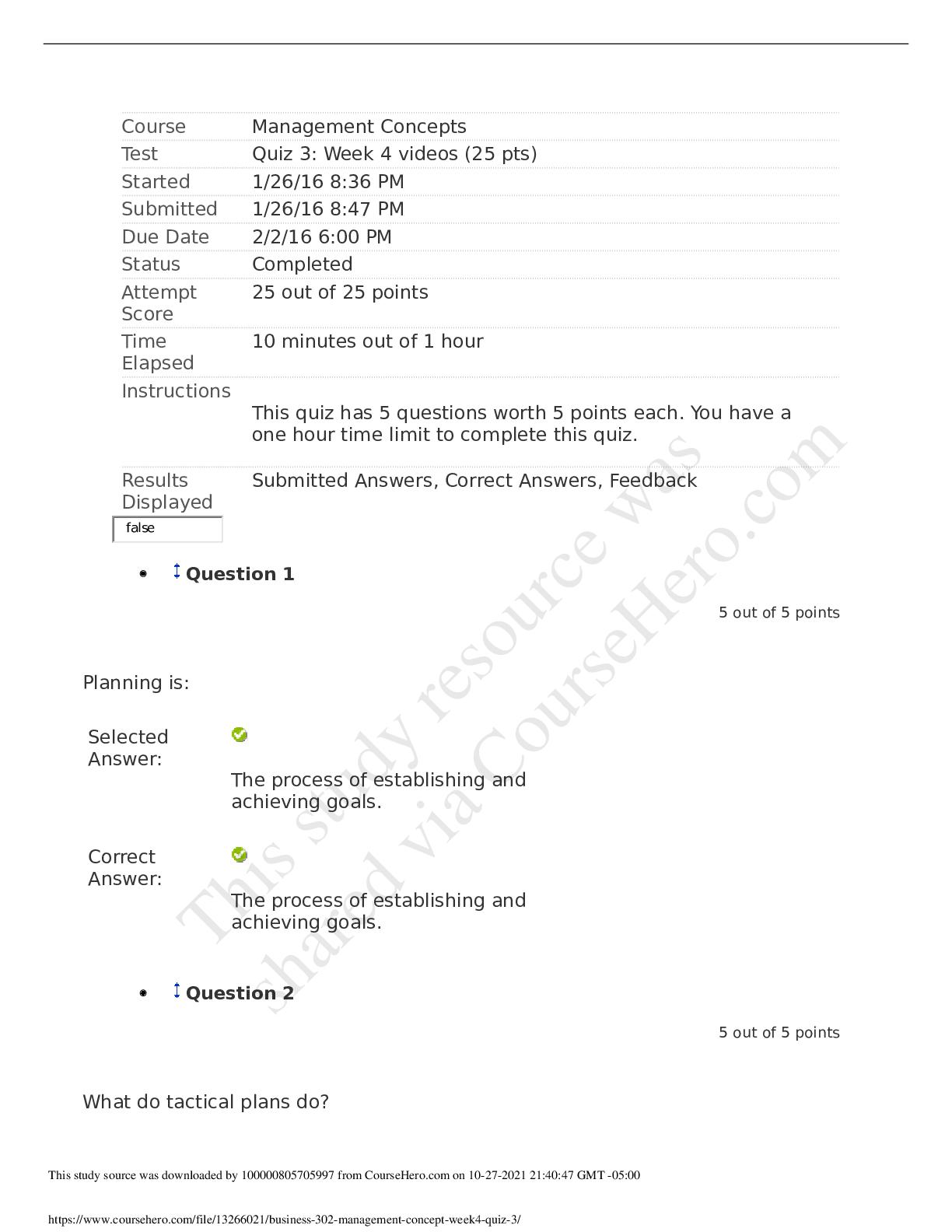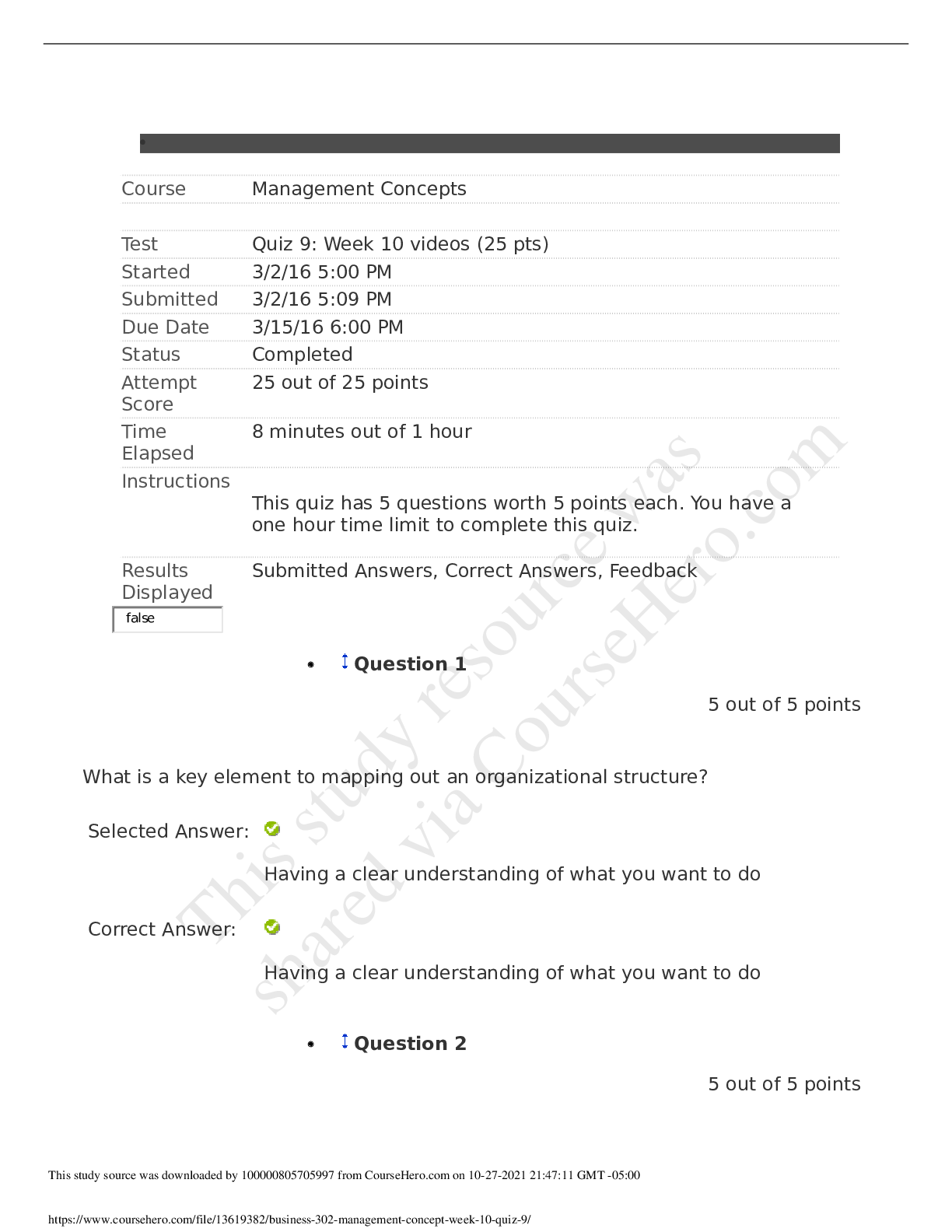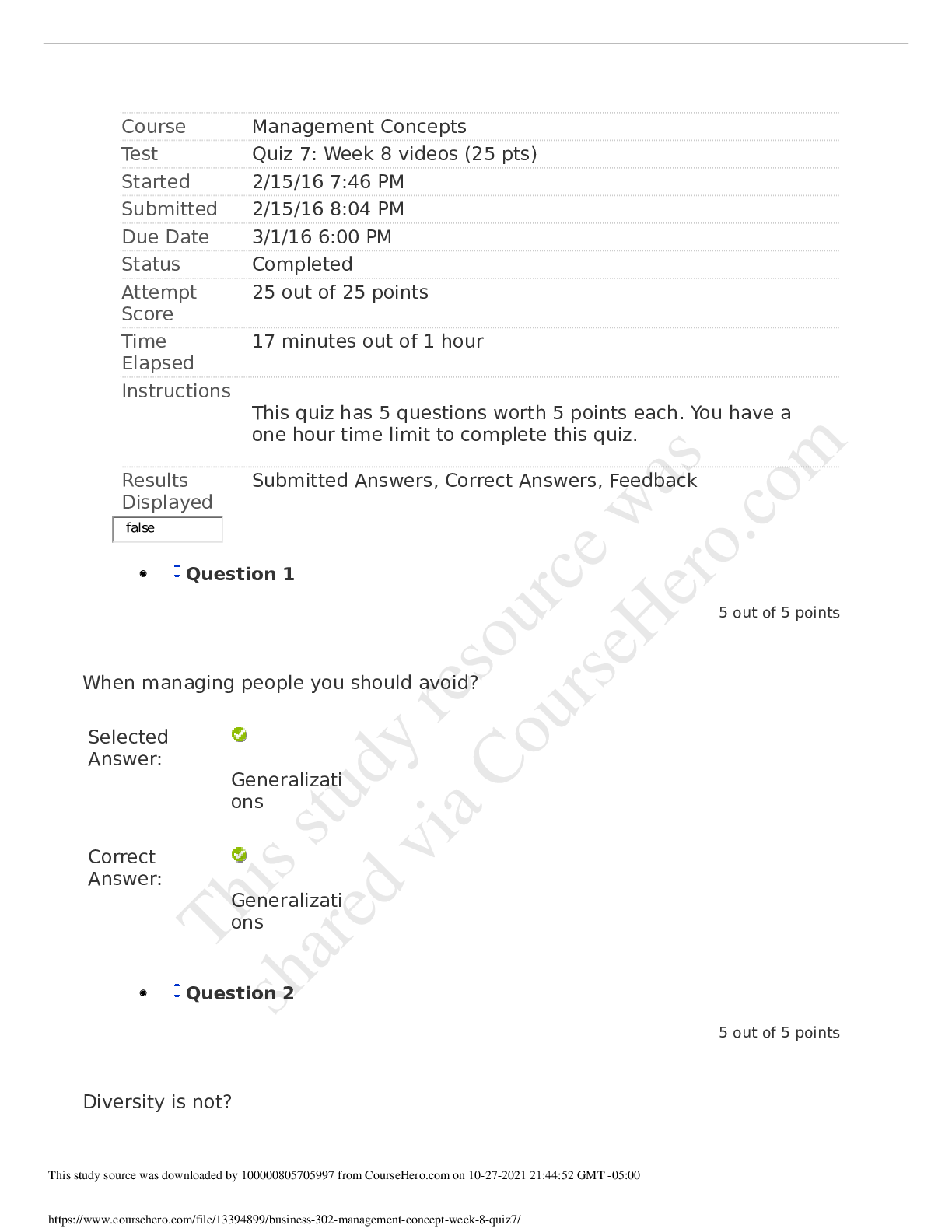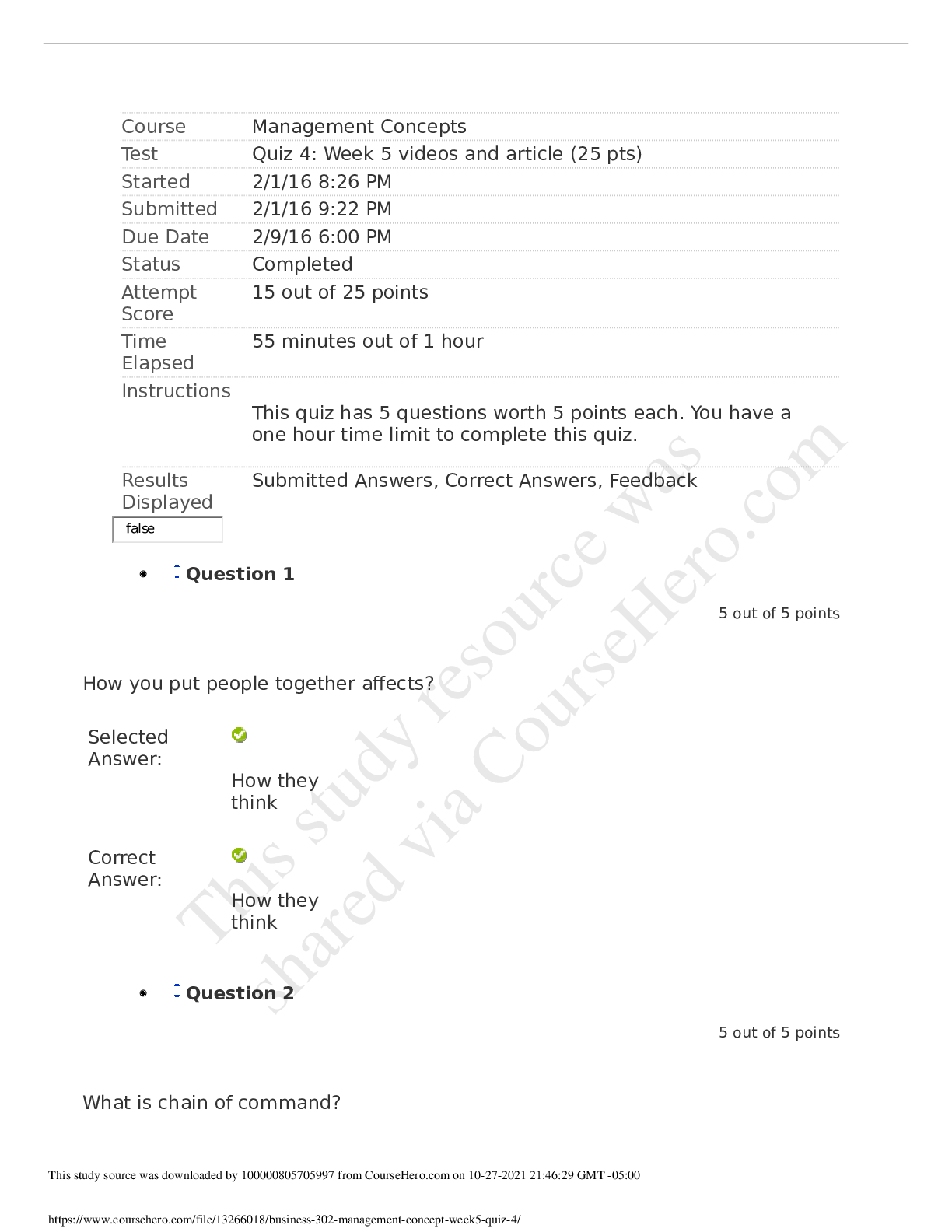Business > QUESTIONS & ANSWERS > [Solved] Economic downturns are generally associated with (All)
[Solved] Economic downturns are generally associated with
Document Content and Description Below
Human Resources (University of Windsor) StudeerSnel wordt niet gesponsord of ondersteund door een hogeschool of universiteit Exam Name ... Economic downturns are generally associated with: high turnover. lower unemployment rates. more competition for qualified employees. an overwhelming number of job applicants for vacancies. skills shortages. 17) 3 The ratio of an organization's outputs to its inputs is known as: the labour market. the equity ratio. productivity. the supply and demand equation. competitive ability. 18) External environmental influences having a direct or indirect influence on HRM include which of the following: labour market conditions. increasing empowerment. organizational climate. decreasing work force diversity. organizational culture. 19) The ratio of an organization's outputs such as goods and its inputs such as capital is which of the following: productivity. outsourcing. an internal environmental influence. workforce diversity. the labour market. 20) When unemployment rates fall: training and retention strategies increase in importance. there is always a greater demand for services. retention strategies increase in importance. there is always a greater demand for services and training strategies increase. unions are more likely to organize workers. 21) Mortgage Financial needs to recruit 10 employees for a period of three months to assist its team of underwriters during the busy season. The company does not want to provide these 10 employees regular full-time or part-time status. As the HR manager, what would you suggest the company do in this situation? increase the workload of staff use contingent employees outsource the underwriting function do nothing about the situation develop a retention plan 22) The characteristics of the work force are known as: unionization. population trends. demographics. diversity. organizational climate. 23) 4 The single most important factor governing the size and composition of the labour force is: the birth rate. population growth. diversity. immigration patterns. the death rate. 24) Any attribute that humans are likely to use to tell them, "that person is different from me," and thus includes such factors such as race, gender, age, values and cultural norms, is known as differences. characteristics. minorities. diversity. perceptions. 25) Baby boomers: have had very high fertility rates. will be increasing rapidly in numbers over the next few decades. resulted in a focus on recruitment and selection in organizations in the past. are currently causing a great deal of competition for advancement. were born between 1946 and 1965. 26) Characteristics of Generation X employees include: mastering of technology. eagerness to make a contribution. a desire for work/life balance. sense of security linked to corporate loyalty. action-orientedness. 27) The Sandwich Generation refers to: Generation Y. employees with older and younger coworkers. individuals with responsibilities for young dependents and elderly relatives. individuals who are caught in the generation gap. employees who have to bring their lunch to work because they can't afford to eat out. 28) If you were the HR advisor of a company where the majority of the workforce consisted of employees born after 1980, what initiatives would you recommend providing to keep the group challenged? job security continuous skill development empowerment and challenging work flexible work arrangements eldercare benefits 29) 5 If you were the HR advisor of a company where the majority of the workforce consisted of employees born before 1965 what initiatives would you recommend providing to keep the group challenged? flexible work arrangements job security independent work eldercare and pension benefits onsite gym facilities 30) Canadians who are functionally illiterate are: exacting a toll on organizations' productivity levels. involved in academic upgrading through their place of employment. older Canadians who did not have the opportunity to attend school. able to perform routine technical tasks without assistance. no longer in the work force. 31) Approximately percent of the Canadian population could be members of visible minorities by 2017. 20 50 30 40 none of the above 32) Which of the following statements is true? Most visible and ethnic minority Canadians are professionals. Ethnic diversity is increasing. Currently, more than 200 different ethnic groups are represented among Canadian residents. The majority of Canadians are of French or British origin. Ethnic diversity is starting to level off in Canada. The proportion of visible and ethnic minorities entering the Canadian labour market peaked in the mid-1990s and is gradually decreasing. 33) Technological advances in manufacturing have: decreased the importance of white-collar jobs. resulted in a decline in the impact of workforce diversity. eliminated many blue -collar jobs. had little impact on service-sector firms. led to significant increases in the employment of persons with disabilities. 34) Which of the following jobs are likely to increase in the market as a result of technological advances? assembly line work professional jobs and managerial positions blue-collar jobs professional jobs no types of jobs will increase 35) 6 Questions concerning are at the core of a growing controversy brought about by the new information technologies. data control, accuracy, right to privacy and ethics privacy and social responsibility speed, accuracy, and efficiency employee stress levels job satisfaction 36) You are the Director of Human Resources at a real estate development company based in Toronto. To attract and retain employees born after 1981 which of the following would be the most strategic to implement? more opportunity to work independently greater job security a comprehensive pension plan an environmental stewardship program eldercare 37) You are the HR generalist of a national railway. Which employment legislation would you refer to when it comes to employee relations issues within the organization? federal provincial territorial provincial/territorial none of the above 38) Which of the following apply to employers and employees across Canada? Employment equity legislation Employment Insurance and employment legislation Employment Insurance and Canada/Quebec Pension Plan Employment Insurance and human rights legislation the Canada Labour Code 39) The tendency of firms to extend their sales or manufacturing to new markets abroad is known as: domestication. globalization. cultural diversity. international marketing. product diversification. 40) The globalization of markets and manufacturing has vastly increased: employee turnover. the quality of products and services. the prices of products and services. standardization practices. international competition. 41) 7 The process of analyzing manufacturing processes, reducing production costs, and compensating employees based on their performance levels is found in: the human relations movement. scientific management. the human resources movement. the scientific movement. none of the above. 42) Which of the following was given emphasis in Frederick Taylor's theory on HRM? cross-functional cooperation compensation tied to performance work conditions job rotation empowerment of employees 43) Management practices in the late 1800s and early 1900s emphasized: workplace harmony. higher wages. empowerment. task simplification and performance-based pay. self-management. 44) Mary Parker Follett was a: believer in self-management. believer in the motivational power of money. supporter of the view that workers are a factor of production. strong advocate of authoritarian management. strong advocate of scientific management. 45) The management philosophy based on the belief that attitudes and feelings of workers are important and deserve more attention is known as: the human relations movement. psychology. socialism. the human resources movement. scientific management. 46) The Hawthorne Studies are closely linked with: the human resources movement. the human relations movement. scientific management. Mary Parker Follett. Frederick Taylor. 47) Which of the following statements is true of the Hawthorne Studies? Worker morale was greatly influenced by such factors as the supervisor's leadership style. Researchers were not interested in the factors influencing worker morale and productivity. Economic incentives were found to be the most closely linked to productivity. The conclusions had little impact on management practices. Treating workers with dignity and respect was found to have a weak correlation to productivity. 48) 8 Which of the following activities was part of the the traditional role of personnel management in the early 1900s? coaching and mentoring handling union-management relations being part of the strategy planning discussions environmental scanning hiring and firing employees 49) In the early 1900s, personnel administration, as it was then called: was closely tied to union-management relations. focussed on trying to improve the human element in organizations. played a very subservient role in organizations. was highly influenced by laws and regulations. served a key advisory role in organizations. 50) The second phase of personnel management arrived in the 1930s with: minimum wage legislation. health and safety legislation. a decrease in unionizing activities. a decrease in unionizing activities and minimum wage legislation. the decreasing momentum of the scientific management movement. 51) If you were an HR professional in the 1940s or 1950s you would likely have had the following activities added onto your portfolio of existing responsibilities: focusing on proactive management. administering benefits. running the payroll department. handling orientation and performance appraisals. hiring and firing. 52) The third major phase in personnel management was a direct result of: government intervention following the depression. a desire for professionalism. the impact of the human relations movement. an increase in unionizing activities. the increasing amount of government legislation. 53) The third phase of personnel management was concerned largely with: health and safety legislation compliance. payroll. corporate contribution and proactive management. corporate contribution. benefits administration. 54) The fourth phase of HRM is ongoing. Current management thinking holds that: employees are quite similar in terms of the rewards they seek. the goals and aims of management must be achieved at all costs. social influences are no longer important to most employees. employees are often the firm's best competitive advantage. employees are motivated primarily by compensation and benefits. 55) 9 Characteristics of a profession include: certification of members. the existence of a common body of knowledge and certification of members. many diverse points of view. government regulation. competing codes of ethics. 56) The broad objectives of HR associations across the country include: assisting in the provision of training in the field of HR. providing opportunities for information exchange. serving as a voice for HR practitioners. skills updating. all of the above. 57) The Canadian national body through which all provincial and specialist HR associations are affiliated is called the: International Personnel Management Association–Canada. Canadian Council of Human Resources Associations. Human Resources Professionals Association of Ontario. Society for Human Resource Management. Canadian Management Association. 58) Payoffs associated with properly implemented ethics programs include: increased stakeholder confidence. greater client/customer and employee loyalty. increased profits. decreased vulnerability to legal liability issues. all of the above. 59) The implied, enforced, or felt obligation of managers, acting in their official capacities, to serve or protect the interests of groups other than themselves, is known as: valuing diversity. legal compliance. social responsibility. professionalism. a code of ethics. 60) Taking a stand on anti-animal testing, human rights protection, and environmental conservation is an example of a firm's: ethics policy. sense of social responsibility. mission statement. desire for legal compliance. code of ethics. 61) TRUE/FALSE. Write ʹTʹ if the statement is true and ʹFʹ if the statement is false. The goal of HRM is to align people practices to organizational strategy to produce behaviours required to achieve organizational goals. 62) 10 HR responsibilities have shifted from operational to strategic responsibilities which involve formulating and executing organizational strategy. 63) An HR professional can build employee engagement by coaching line managers to build trusting relationships with their employees, establishing recognition programs and providing management development programs. 64) Management can lose its authority and power by empowering its employees. 65) HR professionals are increasingly expected by their employers to be change agents who lead the organization and its employees through change 66) The growing emphasis on education and human capital reflects several social and economic factors, such as the increase in primary-sector employment. 67) Recent research indicates that there is a strong positive relationship between employee engagement and organizational performance. 68) Technological advances will continue to shift employment from some occupations to others, while contributing to a decline in productivity. 69) HRM has evolved over the last few decades due to economic forces such as globalization, technological changes, and intense competition, all of which make human capital more important. 70) As an HR professional in today's organizations, you need to be concerned with ethical issues such as security of information, employee and client privacy, governance and conflicts of interest. 71) ESSAY. Write your answer in the space provided or on a separate sheet of paper. Discuss how the impact of HRM on an organization is measured. Discuss the responsibilities of Human Resource Management. You have been hired as the Director of Human Resources at a telecommunications company. Define organizational culture and climate and explain the importance of each to the company. Describe key HRM issues related to demographic trends and workforce diversity. Discuss the theories that have contributed to the evolution of HRM and the challenges faced. Describe the role of ethics in HRM and its challenges and benefits [Show More]
Last updated: 1 year ago
Preview 1 out of 8 pages
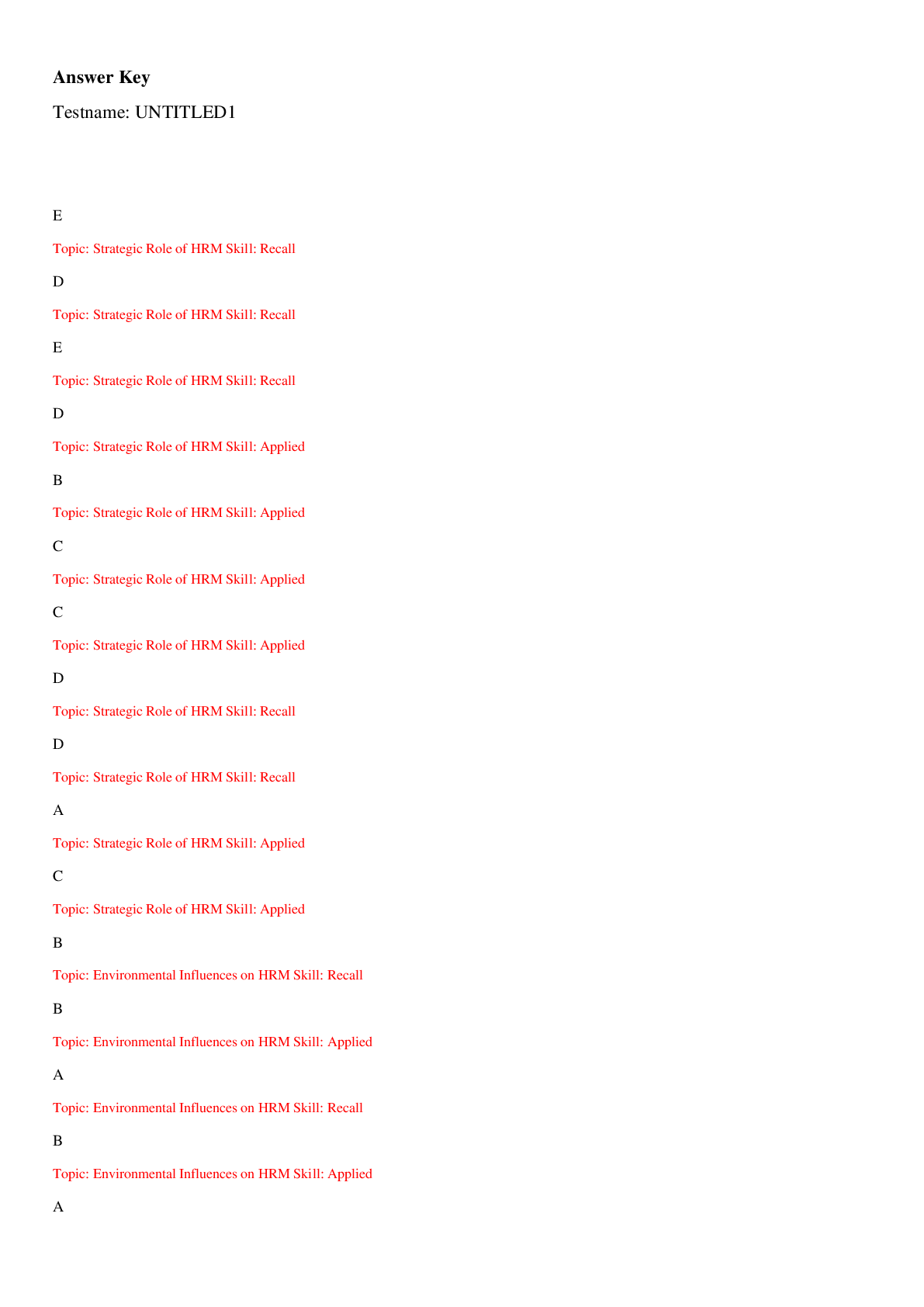
Buy this document to get the full access instantly
Instant Download Access after purchase
Add to cartInstant download
We Accept:

Reviews( 0 )
$30.00
Document information
Connected school, study & course
About the document
Uploaded On
Nov 06, 2020
Number of pages
8
Written in
Additional information
This document has been written for:
Uploaded
Nov 06, 2020
Downloads
0
Views
147

